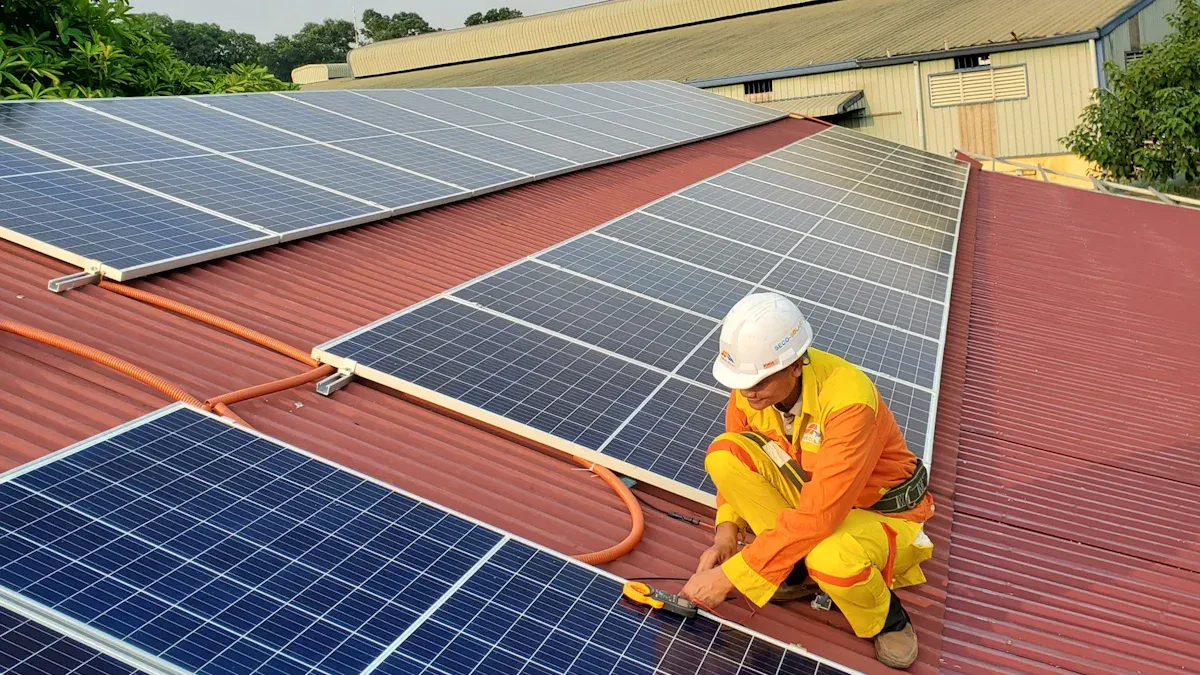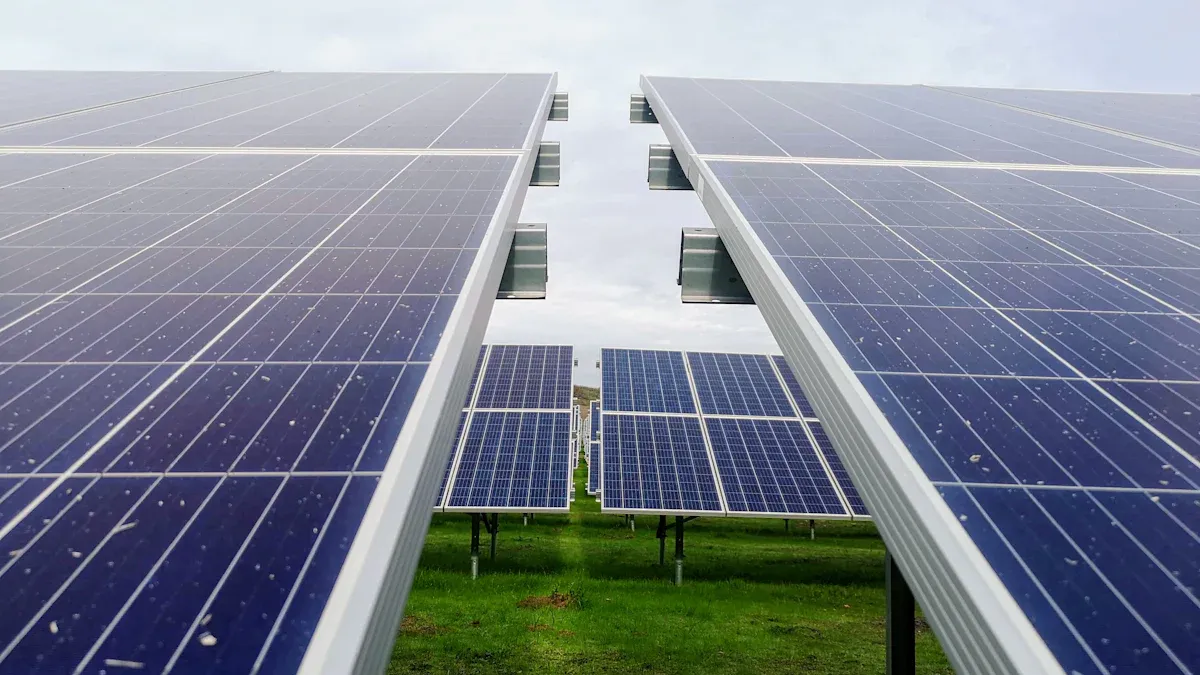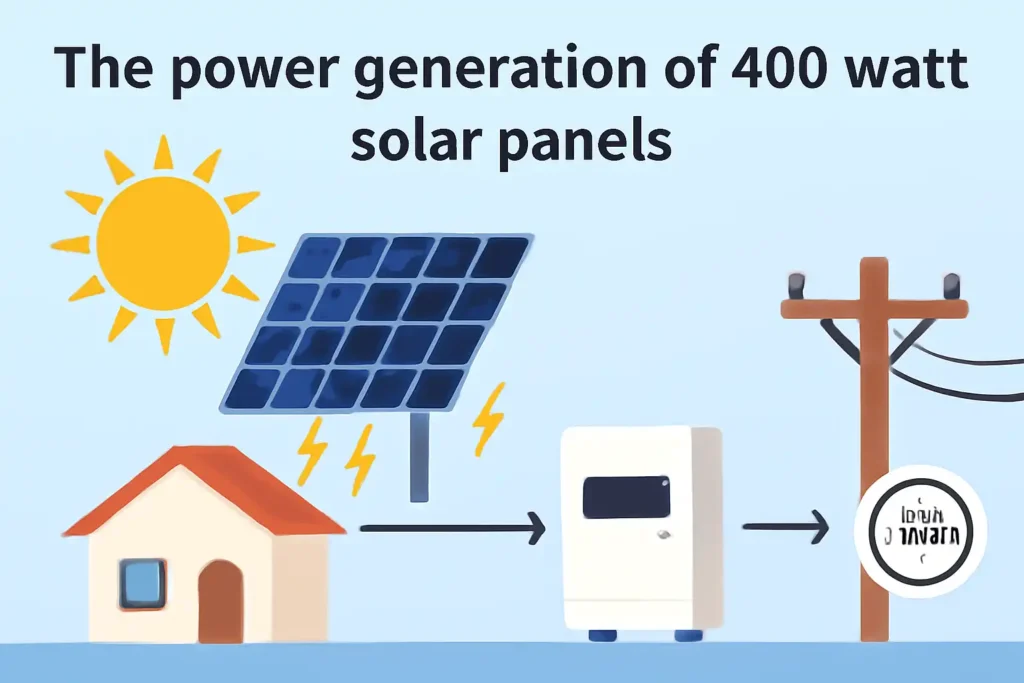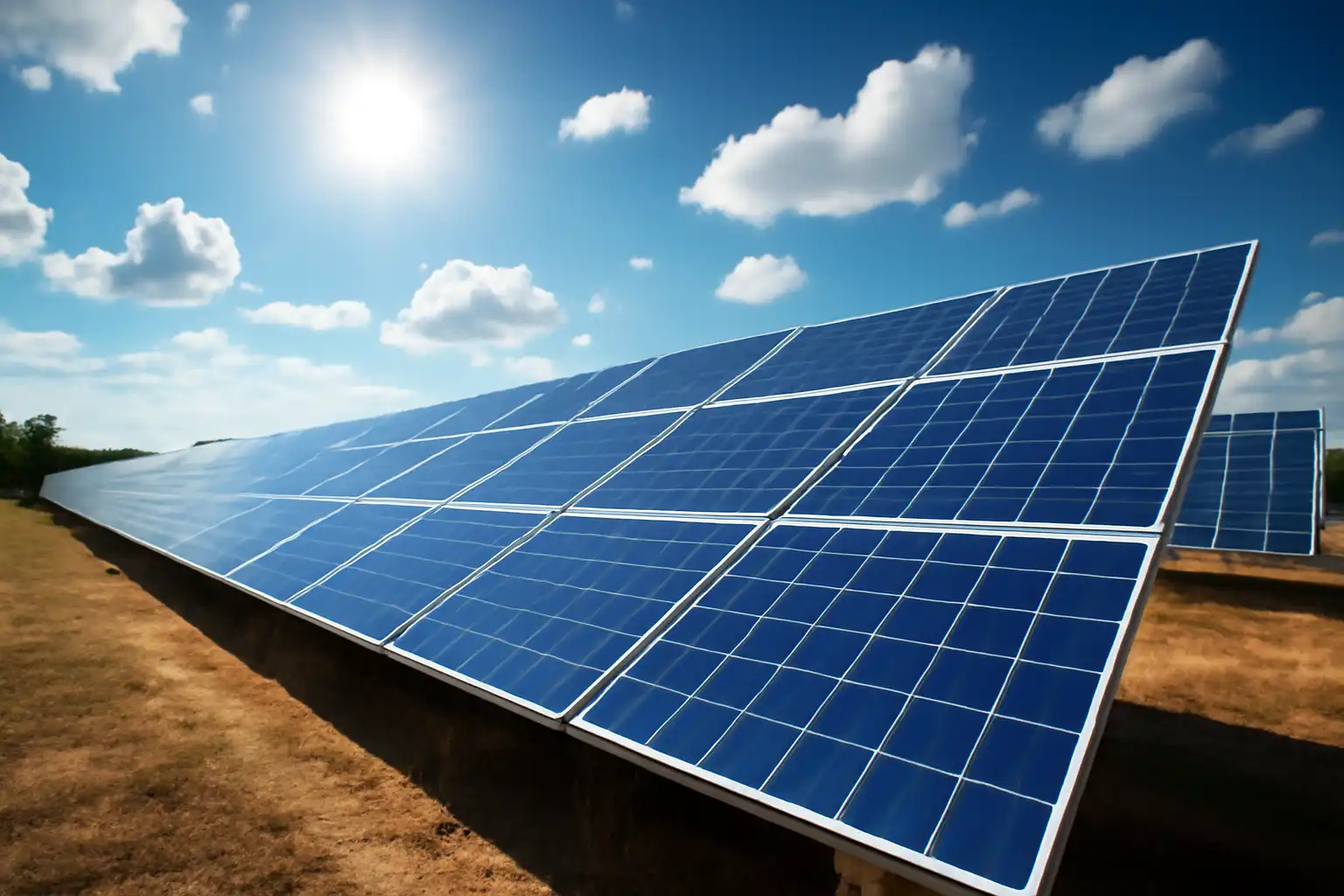To calculate the power generation of a 400-watt solar panel, you can use the formula: Energy = Power × Time. This means that if the panel receives full sunlight for one hour, it will generate 400 watt-hours of energy. However, real-world factors like sunlight availability, heat, and shade can affect this output.
For instance, if you calculate the power generation of a 400-watt solar panel in sunny central Colorado, it might produce approximately 400 kWh annually. On the other hand, the same panel in Michigan might generate only around 280 kWh due to reduced sunlight. Efficiency also plays a key role—a solar panel with 20% efficiency could generate about 200 kWh per year under ideal conditions. Understanding these variables is essential when you calculate the power generation of a 400-watt solar panel to estimate its performance.
Key Takeaways
-
Use the formula Energy = Power × Time to find energy made. For example, a 400-watt panel with 5 sunlight hours gives 2 kWh daily.
-
Think about things like sunlight, shade, and heat. These can change how much energy your panel makes.
-
Keep panels clean and in the right spot. Cleaning and good placement can boost energy by up to 25%.
-
Include efficiency losses when figuring out energy. Use 0.8 to adjust for dirt and shade.
-
Check solar maps or tools for your area’s sunlight hours. This helps you guess how much energy your panel can make.
How to calculate solar power output
Understanding the formula: Energy = Power × Time
To figure out how much energy your solar panel makes, use Energy = Power × Time. This means you multiply the panel’s power (in watts) by the sunlight hours it gets. For example, a 400-watt panel with five sunlight hours makes 2,000 watt-hours (or 2 kWh) of energy.
But real-life conditions are not always perfect. Solar panels are tested under Standard Test Conditions (STC), which assume specific light and temperature. In reality, weather, shade, and panel angle can change sunlight levels. So, the actual energy output may not match the formula exactly.
Tip: Use your location’s average sunlight hours and include efficiency losses for better estimates.
Here are some things that affect solar panel output:
|
Factor |
Details |
|---|---|
|
Importance of Solar Radiation |
Energy depends on how much sunlight hits the panel. |
|
Standard Test Conditions (STC) |
Panels are tested with set light and temperature conditions. |
|
Real-World Conditions |
Weather and shading can lower the panel’s performance. |
Knowing these factors helps you calculate your 400-watt panel’s energy output.
Units of measurement: Watts, kilowatts, and kilowatt-hours (kWh)
To understand solar energy, you need to know the units used. Here’s a simple breakdown:
-
Watts (W): This shows power, or how much energy is made or used at one time. A 400-watt panel makes 400 watts of power in perfect conditions.
-
Kilowatts (kW): One kilowatt equals 1,000 watts. It’s used for bigger systems.
-
Kilowatt-hours (kWh): This measures energy over time. One kWh is 1,000 watts working for one hour. It’s what you see on your electricity bill.
For example, if your 400-watt panel works for five hours, it makes 2 kWh. That’s enough to power a small fridge for a day!
Learning these units helps you estimate your panel’s energy and compare it to your energy needs.
Factors affecting solar panel output

Sunlight availability and peak sun hours
The energy your solar panel makes depends on sunlight. Peak sun hours are very important for this. A peak sun hour means sunlight is 1,000 watts per square meter. For example, if your area gets 5 peak sun hours daily, a 400-watt panel can make 2,000 watt-hours (or 2 kWh) of energy.
Different places get different amounts of sunlight. Sunny areas like Arizona make more energy than cloudy places like Seattle. For instance, 6,650 Wh/m² of sunlight equals 6.65 peak sun hours. This shows that where you live and the season affect your panel’s energy output.
Tip: Use solar maps or online tools to check your area’s average peak sun hours. This helps you better predict your panel’s energy production.
Panel orientation and tilt angle
Where and how you place your solar panel is important. Panels should face the sunniest direction. In the Northern Hemisphere, south-facing panels work best. The tilt angle also matters. Experts say angles between 37° and 47° are ideal, depending on your location. Changing the tilt with seasons can boost energy production.
A study by Hailu et al. (2019) found that wrong tilt angles lower energy output. Dust on panels also reduces energy, so cleaning them helps. If you’re unsure about the best angle, ask a professional or use adjustable mounts.
|
Study |
Findings |
|---|---|
|
Hailu et al. (2019) |
Best tilt angles are 37° to 47°; adjust seasonally. |
|
Khan et al. (2020) |
Tilt angles greatly affect solar panel performance. |
|
Dust Accumulation Study |
Dust lowers energy; cleaning and tilt changes improve output. |
Weather conditions and temperature
Weather affects how much energy your solar panels make. Sunny days are best, but even on cloudy days, panels still work. Snow or ice can block sunlight and reduce energy production.
Temperature also matters. Solar panels work better in cooler weather. Hot temperatures can lower their efficiency. For every 1°C rise, energy drops by about 0.44%. This means panels in hot areas might make less energy than expected.
In summer, panels can make up to 80% more energy than in winter. This is because of longer days and fewer clouds. Plan your energy use based on these seasonal changes.
Note: Clean snow and dirt off your panels to keep them working well, no matter the weather.
Efficiency and shading
Efficiency and shading greatly affect your solar panel’s energy output. Even a small shadow can reduce the power of your 400-watt solar panel. This happens because solar panels have cells linked together. If one cell is shaded, it impacts the whole panel’s performance.
Let’s start with efficiency. A solar panel’s efficiency shows how well it turns sunlight into electricity. Most panels are 15% to 22% efficient. Higher efficiency means more energy, even with less sunlight. But in real life, dirt, dust, and heat can lower the panel’s maximum output.
Shading is also very important. When part of a panel is shaded, energy drops a lot. For example, if 40% of the panel is shaded, power can fall to 253.55 watts. With 60% shading, the output stays around 36.18% of its full capacity. Here’s how shading affects performance:
|
Shading Percentage |
Power Output (W) |
Efficiency Impact |
Temperature (°C) |
|---|---|---|---|
|
0% |
400 |
No impact |
30.0 |
|
40% |
364.82 – 253.55 |
Big drop |
30.6 |
|
60% |
~36.18% of capacity |
Reduced |
30.3 |
|
80% |
~36.18% of capacity |
Reduced |
N/A |
To get the best energy, keep panels away from trees or chimneys that cast shadows. Clean your panels often to stop dirt from blocking sunlight. This helps you produce more energy and meet your needs better.
Tip: Find out your area’s peak sunlight hours to place your panels in the sunniest spot. This helps them get the most sunlight each day.
Step-by-step guide to calculate the power generation of a 400 watt solar panel

Step 1: Find out your area’s sunlight hours
To figure out how much energy a 400-watt solar panel makes, you need to know how much sunlight your area gets daily. This is measured in peak sun hours, which means the sunlight is strong enough to produce maximum energy. One peak sun hour equals sunlight at 1,000 watts per square meter.
You can check your area’s average sunlight hours using online solar maps or tools. These tools give sunlight data based on your location. For example, sunny places like California may get 5 to 6 peak sun hours daily. Cloudy areas like Oregon might only get 3 to 4 hours. Knowing this number is important because it affects how much energy your panel can make.
Tip: Not sure about your area’s sunlight hours? Ask local solar experts or use tools like the National Renewable Energy Laboratory’s (NREL) solar calculator.
Step 2: Multiply sunlight hours by panel power
After finding your average sunlight hours, multiply that number by your panel’s wattage. For a 400-watt solar panel, the formula is:
Daily Energy Output (Wh) = Panel Wattage × Peak Sun Hours
For example, if your area gets 5 peak sun hours daily, the calculation is:
400 watts × 5 hours = 2,000 watt-hours (or 2 kWh)
This means your panel makes 2 kWh of energy daily in perfect conditions. Over a month, this equals about 60 kWh (2 kWh × 30 days). This calculation helps you see if your panel meets your energy needs.
Did you know? Real-world conditions lower energy output. A correction factor of 0.75 adjusts for this. For example:
400W × 5 hours × 0.75 = 1,500 Wh(or 1.5 kWh).
Step 3: Include efficiency losses
Real-life conditions reduce how much energy your solar panel makes. Things like dirt, shade, heat, and panel efficiency affect energy output. To get a better estimate, include these losses in your calculation.
Most solar panels are 15% to 22% efficient. But efficiency drops for several reasons:
|
Factor |
What Happens |
|---|---|
|
Light Reflection |
Some sunlight bounces off instead of being absorbed by the panel. |
|
Energy Loss in Cells |
Some energy is lost before it becomes electricity. |
|
Thin Solar Cells |
Thinner cells absorb less sunlight, lowering energy output. |
To adjust for these losses, multiply your energy output by an efficiency factor. A common factor is 0.8 (or 80%), which accounts for typical losses. Using the earlier example:
2,000 Wh × 0.8 = 1,600 Wh (or 1.6 kWh)
This means your 400-watt panel’s daily energy output would be closer to 1.6 kWh instead of 2 kWh. Over a month, this equals about 48 kWh. Including efficiency losses helps you better plan your energy use.
Pro Tip: Clean your panels often to reduce energy loss. Dirt and debris can block sunlight and lower energy production.
Example calculation for a 400-watt panel
Let’s go through an example to see how much energy a 400-watt solar panel can make in one day. This will show you the steps and help you do it yourself.
Step 1: Collect your information
You need two main pieces of data:
-
Peak sun hours: This is the average number of hours your area gets strong sunlight each day. You can find this using solar maps or tools like the NREL calculator. For this example, let’s say your area gets 5 peak sun hours daily.
-
Efficiency factor: Real-world conditions like dirt, shade, and heat lower the panel’s output. A common efficiency factor is 0.8 (or 80%).
Step 2: Find the raw energy output
Multiply the panel’s wattage by the peak sun hours. This gives the energy before efficiency losses.
Raw Energy Output (Wh) = Panel Wattage × Peak Sun Hours
Raw Energy Output = 400 watts × 5 hours = 2,000 watt-hours (or 2 kWh)
In perfect conditions, your 400-watt panel would make 2 kWh of energy daily.
Step 3: Adjust for efficiency losses
Now, include efficiency losses. Multiply the raw energy output by the efficiency factor (0.8).
Adjusted Energy Output (Wh) = Raw Energy Output × Efficiency Factor
Adjusted Energy Output = 2,000 Wh × 0.8 = 1,600 Wh (or 1.6 kWh)
This means your panel will realistically produce about 1.6 kWh of energy daily.
Step 4: Calculate monthly and yearly energy
To find the monthly energy, multiply the daily output by 30 days. For yearly energy, multiply the daily output by 365 days.
-
Monthly Output:
1.6 kWh × 30 days = 48 kWh
-
Yearly Output:
1.6 kWh × 365 days = 584 kWh
So, your 400-watt panel can make about 48 kWh per month or 584 kWh per year.
Real-world example: Comparing locations
Imagine living in two places: sunny Arizona and cloudy Seattle. Arizona gets 6 peak sun hours daily, while Seattle gets 3. Here’s how the energy changes:
|
Location |
Peak Sun Hours |
Raw Output (kWh/day) |
Adjusted Output (kWh/day) |
Monthly Output (kWh) |
Yearly Output (kWh) |
|---|---|---|---|---|---|
|
Arizona |
6 |
2.4 |
1.92 |
57.6 |
700.8 |
|
Seattle |
3 |
1.2 |
0.96 |
28.8 |
350.4 |
As you can see, energy production depends on where you live. Sunny places like Arizona let your panel make more energy than cloudy places like Seattle.
Tip: Use these steps to estimate how much energy your 400-watt solar panel can make in your area. This helps you plan your energy use and savings better.
What can you power with this energy?
Let’s break it down. If your panel makes 1.6 kWh daily, here’s what it can power:
-
A small fridge (0.8 kWh/day) for two days.
-
A laptop (0.05 kWh/hour) for 32 hours.
-
LED lights (0.01 kWh/hour per bulb) for 160 hours.
Knowing how much energy your solar panel makes helps you decide how to use it wisely.
Pro Tip: To get the most energy, keep your panels clean and away from shade. Regular maintenance can improve your energy output a lot.
How to optimize the output of 400-watt solar panels
Correct setup and panel direction
Setting up your solar panels correctly is very important. The way you angle and position them affects how much sunlight they collect. Here’s what to do:
-
Adjust the tilt to a lower angle for better energy.
-
In the northern hemisphere, aim panels south for more sunlight.
-
Roof direction matters. South-facing roofs are best, but east or west roofs can work with changes.
Good positioning helps your panels get sunlight all day. If you’re unsure about angles, ask a solar expert or use adjustable mounts to make changes.
Tip: Change the tilt angle during seasons to improve energy output.
Cleaning and regular care
Dust and dirt can lower your solar panel’s efficiency a lot. Cleaning them often keeps them working well. Dirty panels can lose up to 25% efficiency, and in dusty areas, this can go up to 30%.
Why cleaning is important:
-
Dust can cut solar panel energy by up to 85%.
-
Dirt-covered panels take in less sunlight, reducing energy.
-
Cleaning clears sunlight-blocking dirt, keeping performance steady.
Clean your panels regularly, especially in dusty places. Use a soft brush or water to clean without scratching them.
Pro Tip: Check for cracks or loose parts while cleaning. Fixing these helps maintain energy production.
Adding solar tracking systems
Solar tracking systems help your panels make more energy. These systems move the panels to follow the sun all day. This way, the panels always face the sun directly.
Why tracking systems are helpful:
-
Boost energy by up to 25% compared to fixed panels.
-
Reduce shading problems by keeping the best position.
-
Work better during peak sunlight hours, even with changing sunlight.
Tracking systems cost more at first but give more energy over time. If you want the most energy, think about getting one.
Note: Tracking systems are best for sunny areas. In cloudy places, fixed systems might save more money.
Keeping panels away from shade and blockages
Shade and blockages can greatly lower your solar panel’s energy. Even a small shadow from a tree or building can cut its power. To get the best from your 400-watt solar panel, keep it in full sunlight.
Why shade is a problem
Solar panels turn sunlight into electricity. If part of the panel is shaded, it stops sunlight from reaching the cells. This doesn’t just affect the shaded part—it can reduce the whole panel’s power. For example, if 30% of the panel is shaded, the energy loss could be more than 30%. That’s a big drop!
Ways to avoid shade
Here are simple tips to keep your panels clear:
-
Pick a sunny spot: Place panels where they get sunlight all day, like on roofs or open spaces.
-
Trim trees: Check for branches that might block sunlight and cut them back.
-
Stay away from tall objects: Avoid placing panels near chimneys, antennas, or tall buildings.
-
Check for seasonal changes: Shadows move as the sun’s angle changes during the year. Look at your panels in different seasons to ensure they stay in sunlight.
Tip: Use tools like a solar pathfinder to find the best spot with no shade before installing your panels.
What to do if shade is unavoidable
Sometimes, you can’t avoid shade, especially in crowded areas. In these cases:
-
Try microinverters or power optimizers: These let each solar cell work on its own, reducing shading problems.
-
Use adjustable mounts: Move or tilt panels to avoid shadows during peak sunlight hours.
-
Install fewer panels in shaded spots: Focus on placing panels in the sunniest areas for better energy.
Keeping your panels free from shade and blockages helps them work better. A little care and planning can make a big difference in your solar energy output.
Practical uses of knowing solar panel output
Figuring out energy savings
Knowing how much energy your solar panels make can show how much money you save on electricity. You can calculate daily, monthly, or yearly energy to compare with your home’s needs. For example, if your solar setup costs $20,000 and saves $840 each year, it will take 24 years to pay off. This helps you decide if solar is worth the cost.
“Researchers found that in 2017, solar investments without subsidies didn’t break even. But when health benefits were added, solar broke even in 30% of cases studied. This shows solar has big economic and health impacts.”
To save more, think about panel efficiency and sunlight hours. For example, a 200-watt panel with 85% efficiency and 4 sunlight hours makes 680 watt-hours daily. These numbers help you see your possible savings.
Running small devices and appliances
A 400-watt solar panel works well for small devices and appliances. It can make about 2 kilowatt-hours of energy daily in good conditions. This is enough to power laptops, LED lights, or a TV for hours.
Here’s what a 400-watt panel can handle:
|
Device Type |
Power Needed (Watts) |
Works with 400W Panel? |
|---|---|---|
|
Household electronics |
50 – 200 |
Yes |
|
Microwave |
600 – 1200 |
No |
|
Washing machine |
500 – 1500 |
No |
|
Refrigerator |
100 – 800 |
No |
|
Television |
50 – 400 |
Yes |
|
Laptop |
50 – 100 |
Yes |
|
Gaming console |
100 – 300 |
Yes |
For bigger appliances like fridges or microwaves, you’ll need more panels. But for smaller items, one 400-watt panel works great.
Off-grid systems and backup power
Solar panels are great for off-grid living or backup power during outages. By knowing your panel’s energy output, you can figure out how many panels and batteries you need.
|
Evidence Type |
Details |
|---|---|
|
Performance Studies |
Research shows modern panels rarely fail and often make more energy than expected. |
|
Optimization Tools |
NREL’s REopt tool helps design solar and battery systems for savings and reliability. |
|
Quality Improvements |
NREL creates standards to improve solar system performance worldwide. |
Adding a battery lets you save extra energy for nighttime use. Tools like NREL’s REopt help plan systems that balance cost and energy needs. Whether you live off-grid or want backup power, solar panels are a reliable choice.
Figuring out how much energy a 400-watt solar panel makes is easy. First, check how many sunlight hours your area gets. Then, multiply that by the panel’s wattage. Don’t forget to adjust for energy losses like dirt or heat. This gives you a good idea of how well your panel works.
Keep in mind, things like weather, shade, and heat affect energy. For instance, knowing how temperature changes efficiency or using the Performance Ratio (PR) helps compare real and expected power.
Using these steps, you’ll learn your panel’s energy potential. Plus, you can plan better for saving energy and money. Why not try it today? 😊
FAQ
What does a 400-watt solar panel power?
A 400-watt solar panel can power small devices like laptops, LED lights, or a TV. It generates about 1.6 kWh daily under real-world conditions. That’s enough to run a small fridge for a day or charge your phone multiple times. 🌞
How do I calculate my solar panel’s energy output?
Multiply your panel’s wattage by your area’s peak sun hours. Then, adjust for efficiency losses (around 20%). For example:400W × 5 hours × 0.8 = 1.6 kWh/day.
This gives you a realistic estimate of daily energy production.
Can weather affect my solar panel’s performance?
Yes, weather plays a big role! Cloudy days reduce sunlight, lowering energy output. Hot temperatures can also decrease efficiency. However, panels still work in indirect sunlight, and cooler weather often improves performance. Keep your panels clean for the best results. 🌦️
How do I maintain my solar panels?
Clean them regularly to remove dirt and dust. Use a soft brush or water to avoid scratches. Check for cracks or loose parts during cleaning. Trim nearby trees to prevent shading. Proper care ensures your panels stay efficient and last longer. 🧹
Are solar panels worth it in cloudy areas?
Yes, they can still work well! Panels generate electricity even on cloudy days, though output is lower. If your area gets at least 3 peak sun hours daily, solar panels can still save you money over time. Use tools like solar calculators to estimate your savings. ☁️
The following information may be of interest to you
How to calculate the capacity of a circuit breaker
Can solar panels work on cloudy days
Is a 3 kW Solar System Suitable for Your Home’s Energy Demands





